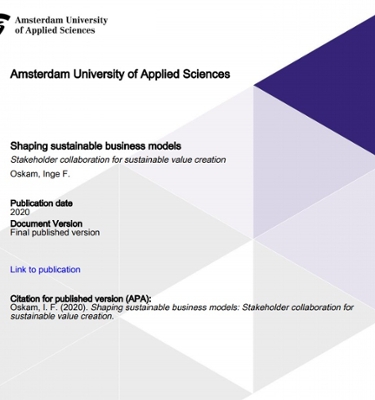Shaping sustainable business models
Stakeholder collaboration for sustainable value creation
Anders
Recent economic crises, environmental problems and social challenges have urged us to drastically change our consumption and production patterns and transform organisations to contribute to socio-technical transitions that positively impact these challenges. Therefore, sustainable development and the transition towards a circular economy are gaining increased attention from academics and are being widely adopted by national and local governments, companies and other organisations and institutions. Since the implementation of more sustainable solutions lags behind expectations and technological possibilities, scholars and practitioners are increasingly seeing sustainable business model innovation as the key pathway to show the value potential of new sustainable technology and stress the importance of integrating the interests of multiple stakeholders and their economic, environmental and social value goals in the business model’s development. However, there is limited research that elucidates which stakeholders are actively involved, how they interact and what the effect is on the collaborative business modelling process for sustainability. This thesis addresses this research gap by building on the notion of business models as boundary-spanning activity-systems and studies stakeholder interaction from the level of a focal firm, as well as from the level of cross-sector actors collaborating in innovation ecosystems.
Through four independent studies, three empirical studies and a design science study, this thesis aims to provide a better understanding of how stakeholder interaction affects collaborative business modelling for sustainability.
The first study (Chapter 2) took a process perspective on interaction with network ties from the perspective of a focal firm. Based on two case studies of SMEs successfully introducing sustainable technology in the market, value shaping was identified as the operative mechanism describing the relation between networking and business modelling, from ideation to growth of the business. A stage model with five successive forms of value shaping describes how, in each stage, interaction with network ties help firms to clarify the types of economic, environmental and social value that a sustainable technology can deliver and who possible beneficiaries are. In return, changes in the business model clarify what other network ties are needed, demonstrating how the boundary-spanning function of business models spurs firms to expand and strengthen the value network.
The second study (Chapter 3) focused on the commercialisation stage, in which a cognitive change in the manager’s mind was found during the development of a sustainable business model. Based on three empirical cases of business model innovations for sustainability, the study explored how stakeholder interaction may trigger and support managerial cognitive change and hence business model innovation. The findings suggest that the influence of stakeholders on the manager’s understanding of the business runs via three interrelated shaping processes: market approach shaping, product and/or service offering shaping and credibility shaping. In these shaping processes, new or latent stakeholders are found to have a bigger impact than existing ones. A research agenda is presented to further unravel the role of stakeholders affecting managerial cognition around business model innovation for sustainability.
The third study (Chapter 4) examined innovation ecosystems’ processes of developing a collaborative business model for sustainability. Based on a study of four sustainably innovative cross-sector collaborations, this chapter studied how innovation ecosystems resolve the tensions that emerge from the collaborating actors’ divergent goals and interests. This study finds that innovation ecosystems engage in a process of valuing value that helps the actors to manage the tensions and find a balance of environmental, social and economic value creation and capture that satisfies all involved actors. The findings reveal that valuing value occurs in two different patterns – collective orchestration and continuous search – that open up a research agenda that can shed further light on the conditions that need to be in place in order for an innovation ecosystem to develop effective sustainable business models.
The final study (Chapter 5) used a design science approach, developing a tool for innovation ecosystems’ actors to manage the degree to which stakeholders are involved throughout the process of collaborative business modelling for sustainability. The resulting ‘degree of engagement diagram’ and accompanying stepwise approach makes it possible to identify stakeholders from six cross-sector stakeholder groups that represent economic, social and environmental aspects of sustainable value and visualise their roles. By discriminating between four concentric and permeable circles of engagement, the tool integrates different degrees of involvement of stakeholders and enables users of the DoE diagram to accommodate changes that may occur in the evolving business model and its context. The tool enables innovation ecosystems’ actors to keep the collaboration manageable during the development of a joint and viable sustainable business model.
Overall, this thesis extends the understanding of the dynamics of collaborative business modelling for sustainability and the role of stakeholder interaction therein. The research makes three key contributions to the sustainable business model innovation literature. First, it extends the literature by exploring the interplay between stakeholder interaction and business modelling over time. It establishes that stakeholder interaction and business modelling have a reciprocal relationship and contributes with two frameworks – value shaping and valuing value – that explain this reciprocal relationship for firms and innovation ecosystems. Second, the thesis unravels the micro-processes and mechanisms that elucidate how stakeholder interaction actually influences the direction into which the sustainable business model develops. Third, this thesis enriches the scholarly understanding of stakeholder interaction by identifying the main contributors to business model innovation for sustainability, by differentiating between stakeholders and their roles and by providing a tool that accommodates this. The research contributes to practice by offering practitioners useful insights on how they can increase, improve and effectuate stakeholder interaction in order to develop viable business models for sustainability and hence contribute to the desired socio-technical transitions.

